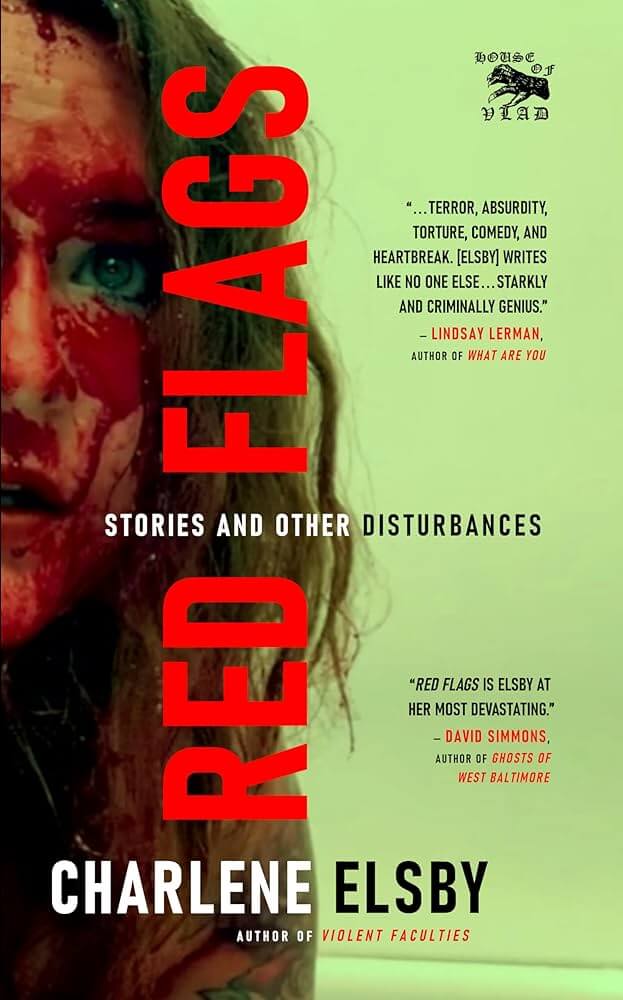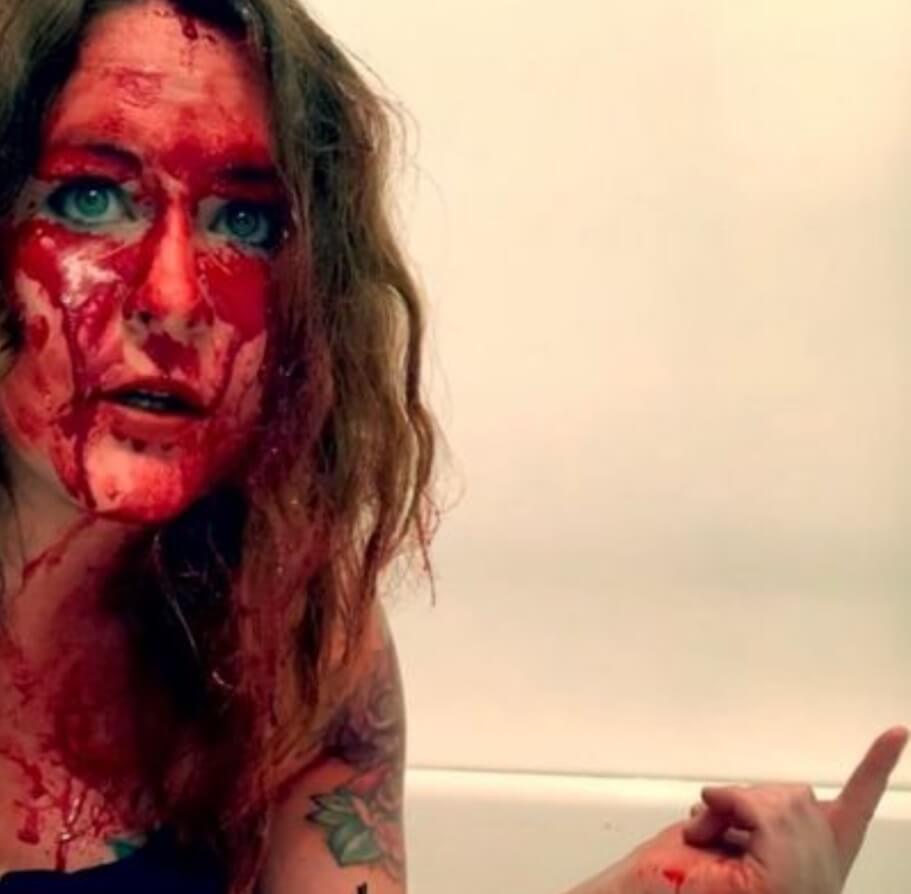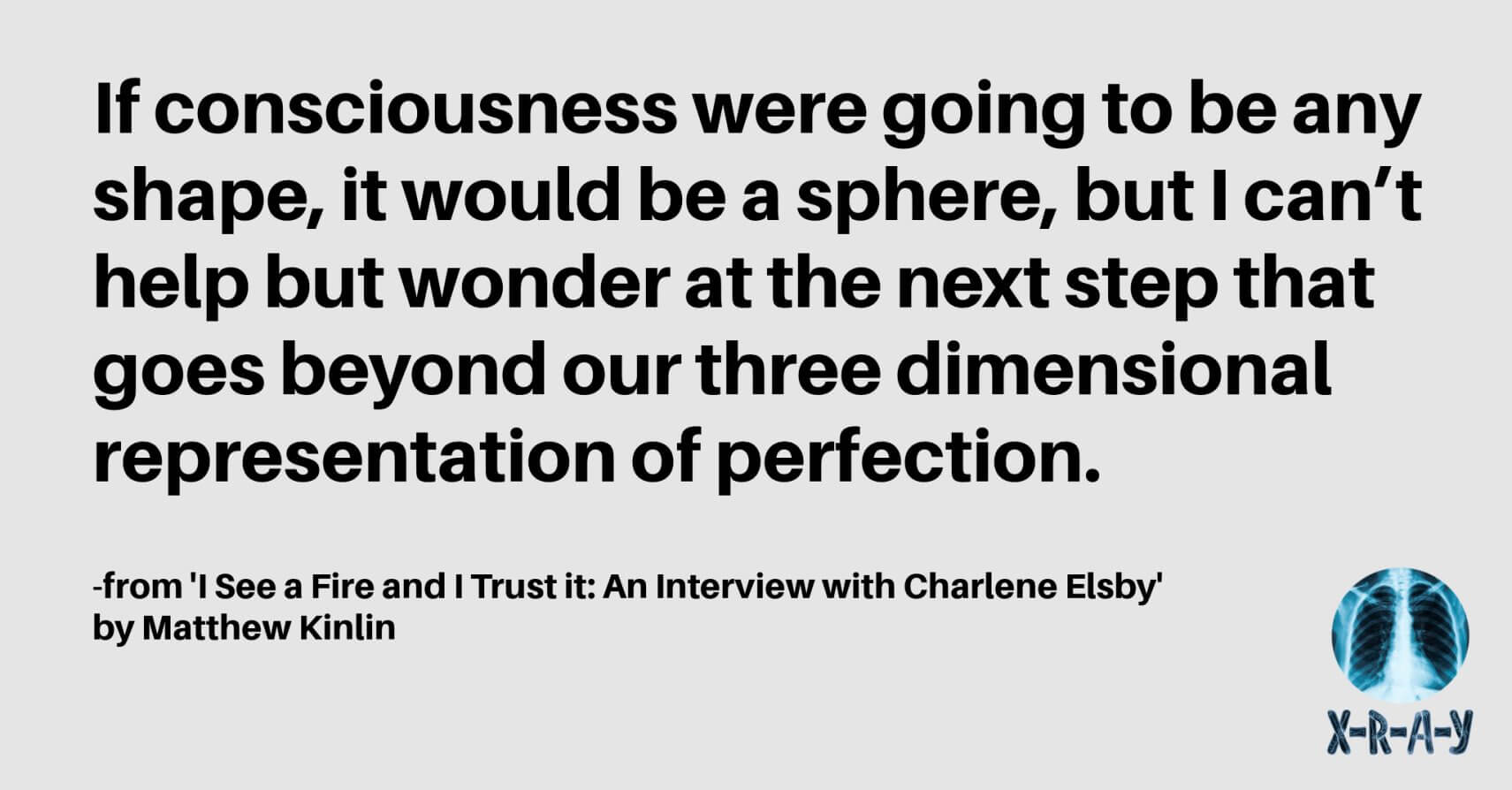Matthew Kinlin: In Ingmar Bergman’s The Seventh Seal, Death states to Max von Sydow as the medieval knight: “Most people think neither of death nor nothingness.” Your new collection of stories, Red Flags (House of Vlad, 2024), offers characters the opportunity to think about their own deaths as experienced, often occurring in gruesome and funny ways. What motivated you to write about this confrontation with death and non-existence?
 Charlene Elsby: Hello, Matthew! It’s funny I should hear from you just now, which I’ll explain in just a moment. But first the answer to your question. I was at home when the Facebook group for the neighbourhood started showing up in my notifications, as a woman had been hit and dragged at the intersection outside my apartment. Now I’ve always been a little taken aback at how we’re all able to go about our lives, given that death threatens us nearly constantly. And it reminded me of a pamphlet that I was given at a palliative care house when we were watching my stepmother pass. For a couple of weeks we were there nearly constantly, my father sleeping in a chair next to her bed, and I going home nights and returning in the day to bring food and allow him time to go home to bathe. The pamphlet told us that we should not expect our loved ones to have any new or profound thoughts or insights as they approach the other side–and that while we often expect this of the dying, it is unfair to impose upon them like that. Thus I wrote the first story of the book, and the other seven following the same general theme.
Charlene Elsby: Hello, Matthew! It’s funny I should hear from you just now, which I’ll explain in just a moment. But first the answer to your question. I was at home when the Facebook group for the neighbourhood started showing up in my notifications, as a woman had been hit and dragged at the intersection outside my apartment. Now I’ve always been a little taken aback at how we’re all able to go about our lives, given that death threatens us nearly constantly. And it reminded me of a pamphlet that I was given at a palliative care house when we were watching my stepmother pass. For a couple of weeks we were there nearly constantly, my father sleeping in a chair next to her bed, and I going home nights and returning in the day to bring food and allow him time to go home to bathe. The pamphlet told us that we should not expect our loved ones to have any new or profound thoughts or insights as they approach the other side–and that while we often expect this of the dying, it is unfair to impose upon them like that. Thus I wrote the first story of the book, and the other seven following the same general theme.
Now it’s interesting that you should bring this up now, as I’ve just awoken in my chair and, in that space between sleep and waking, I saw my stepmother’s head in what turned out to be a scarf bunched around a hanger on the drying rack. A psychic told me three months ago that there was a woman with short, curly hair watching over me, and I believed that it was her. When she passed, I used to have dreams that she was calling me from farther and farther distances away, until one day she appeared in full opacity, to tell me that she was fine. Those dreams completely ended after that final encounter, so it was strange to be thinking of this when you wrote to me.
Does the air seem to have a strange scent where you are?
MK: There are some strange coincidences in what you have just described. As we are speaking, there is a thunderstorm. It is the first one in a long time. This week has been unusually hot for England in September, I assume due to the climate crisis. It was really hot this week and that changed today to an intense heaviness and a charged smell in the air, some atmospheric tension. I can hear thunder breaking. I am staying at my boyfriend’s family home today and as I got out my laptop, his mother’s scarf fell off the end of the couch. I have been having vivid dreams over the last few weeks but they are hard to recall. It’s emotional to hear about the dreams of your stepmother calling you and her then telling you she was OK.
Do you believe in coincidences? The narrator of your story “The Most Beautiful Woman in the World” states: “I was supposed to be here.” Are the most trivial of details, such as a crease in a scarf, part of some predestination?
I’m also thinking of the initial name for August Strindberg’s Occult Diary, which was Strange Coincidences and Inexplicable Events. Today’s date is Saturday 21st September. When I look at Strindberg’s diaries, he writes on September 19th, 1896: “Letter from Hedlund about the Cyclone in Paris… The night after this a storm broke out at midnight and lasted until 2.” He writes nothing again until September 23rd. Strindberg often seems to link scarves and death. He writes: “In the morning when I awoke I saw Harriet life-size dead on my sofa. She had a white scarf across her mouth; in a white blouse with a black skirt.” Like yourself, he saw a human face in a scarf: “On Tuesday 28 April in the morning I saw a skull (made of my scarf and petit Larousse).” Finally, he writes, “A woman by the stream when we were about to leave: she had a scarf over her head but a light band across her forehead with a red circle and a half moon; looked like a blood stain.” Upon reading this, I thought of the photograph of yourself in Red Flags, completely covered in blood.
CE: I do believe in strange coincidences. I believe we are supposed to be here, discussing scarves beneath Magritte’s The Lovers II. I bought the print after seeing it in Belgium and according to the curator’s note at the museum, the people in Magritte’s paintings are covered in cloth because they are dead, and one of the people in this painting is his mother.
That same journey, I happened by accident upon the portrait of Strindberg by Edvard Munch in the Museum De Reede in Antwerp. I recognized it immediately from the cover of the Penguin translation of Inferno and From an Occult Diary I used to carry around as a teen. But never before had I noticed the spelling error in Strindberg’s name–and it’s because it wasn’t there. At some point, the error in the lithograph was corrected but in person, there it was, or rather, there it wasn’t–a missing R. I’d like to know where that symbol has gone. Does a missing R mean anything to you?
The blood has been there since Hexis, Matthew. I filmed a reading and put the screenshot on Youtube. A still from that video was already used on the cover of Excuse Me Mag. This is another still that Brian took from my Instagram. The blood is still there, Matthew. Get it off, get it off, get it off. Do you have a scarf I could borrow to wipe it away, or are your scarves woven with death in the fibres?

The coincidences increase in frequency the closer to our fate we become.
MK: I can feel these coincidences intensify as we speak. I have the same Penguin edition with the same Munch cover. This week, I have been watching over and over a scene from a 1980 TV movie of Ursula Le Guin’s The Lathe of Heaven about a man whose dreams can distort past and present reality. In this scene he is put under hypnosis and told to have a dream about a horse once he hears a specific word. The word is Antwerp.
I keep thinking about the dream you had. I keep thinking how red flags are technically the same as red scarves. Maybe all scarves are woven with death.
The missing letter R has meaning to me. When I was a teenager, a dog in Mallorca tore my hand open. There was blood then too, Charlene. When I think of R, I hear the growling sound of the dog. I think the nurse in Romeo and Juliet (two dead lovers) calls the letter R, “the dog’s name.” When I look in Strindberg’s diaries, he puts dog, horse and Munch all together in two lines on 21st February, 1896: “The carnassial tooth = the horse’s hoof fell after much noise during the night. The dog in Munch’s yard.”
His next line is: “The magic whip in Luxembourg.” I’m starting to feel afraid. Are we being punished by some unknown daemon? In your story “A Little More Spontaneous”, the narrator states: “Fate is laughing at me.” What is this conspiracy? Are we being whipped? I’ve just found out that the first German and Portuguese editions of Le Guin’s novel translate as Die Geißel des Himmels and O flagelo dos céus, which literally means: “the scourge [or whip] of heaven”. The second edition translates as: “the other side of the dream”. Maybe the dead live on the other side of our dreams.
CE: I refuse to dream of a horse. I won’t have it! All that sobbing. The coachman will continue to beat the horse as soon as you let go of its neck. It’s all in the unseen.
You’re right that we are being whipped, and I think maybe it’s because I’ve been missing something. I have always supported the concept of an other side that is the unseen aspect of the visible / conceivable. But the way in which someone or something appears in a dream is another form of presentation. If that’s where the dead are, it would explain a lot. A lot of a lot.
In the dream, there is some other form of action in which we are not engaged. And by that I mean that while we act, the action is passive, and I seem to have no control over what is occurring or what it is that I do. If consciousness is the realm of activity and there is another realm where the activity is passive, then that explains how death as the ceasing of action finds its place on the other ends of dreams.
But what if we pulled the cord?
(I think we have to.)
MK: I’m afraid again, to pull the cord. It would be like unravelling the thread of a scarf and I am not sure where we would end up. Where the scarf ends or the air begins? There’s so many molecules in heaven. I remember finding a paperback copy of Strindberg’s The Ghost Sonata in a second-hand shop as a teenager. It filled my mind with a strange green fog.
Nietzsche wandering from his residence to the Piazza Carlo Alberto on 3rd January 1889. It was here he saw the horse being whipped. It was inside this elegant square that his mind unravelled in red threads. Is consciousness a square or a circle? Only a few months before Nietzsche met his pale horse of Death, he started writing letters to Strindberg in the winter of 1888. Nietzsche wrote to him, “I believe that I have become familiar with more evil and more questionable worlds of thought than anyone else, but only because it lies in my nature to love what lies apart.” What is this land of exile where death dances with madness? What is this realm where activity is passive?
I am trapped inside my dreams. I have dreams of the dead too, like you told me before. In the dream, I am by the sea. I have never lived by the sea. But in the dream of the dead, there is always water. Where are we floating to? In your story “A Little More Spontaneous”, you write, “Being a dead person was as free as it gets.” A person at the moment of death. It’s like waiting to fall asleep; we are unable to pinpoint the moment when the sea sweeps us away. I wonder how it felt when the azure sky came crashing down in Turin.
CE: If consciousness were going to be any shape, it would be a sphere, but I can’t help but wonder at the next step that goes beyond our three-dimensional representation of perfection. You know that the code for all that is, is contained within the ratio of the diameter to the radius, and that the “heavens” as they were called (Mars, Venus, Jupiter, etc.) are embodiments of the equidistance from centre that defines material perfection. The human head approximates their shape as best it can and tries to reach those other spheres in the skies, sitting atop the human body as it does.
I’m tired of this emaciated notion of causality that puts all precedence in the past. The future is as much a cause of the present as anything that’s happened before, and it is what chains us and confines us in all present actions. The threat of it drowns us in limitations and contrives to bury us in limitations–the fact that it does not exist is not a limit to its power. We must instead conclude that what does not exist is a primary and immediate cause of all that is.
Have you read By the Open Sea? I’ve just opened it to a random page that makes me concerned for you: “He slept badly in spite of all his attempts to regulate his dreams by strong auto-suggestions before falling asleep. Sometimes he awoke from a dream that he was a bell-buoy, drifting and drifting in search of a shore on which he could be thrown. And in his sleep he had pressed close against the bedstead, so as to feel the contact of some object, even if it were an inanimate one.”
It seems very lonely.
MK: I’ve not read By the Open Sea but will do so. Strindberg is a strikingly lonely figure. I think about The Ghost Sonata where spirits appear in bright daylight. My dreams are lonely realms. I think Deleuze spoke about the aim of his teachings was to reconcile ourselves with our own solitude. The open sea brings me back to Bergman and to the opening of the interview where a man meets Death, which brings me back to Red Flags. Consciousness encounters non-existence for a few fleeting moments which are like an eternity upon Death’s oceanic cloak, the endless crashing of waves upon a stone beach. In this interview, we have come upon the following possible points:
1. The dead exist on the other side of dreams.
2. Death, like dreaming consciousness, as a form of passive activity.
3. Death, like the future, as a form of non-existence acting on the present.
4. Death corrupts the metaphysical rules of causality.
What is the solitude of death? I think of the stars above the sea, globes of fire that as you say, mirror the imperfect human head. Archimedes writing On the Sphere and Cylinder, which mirrors the human head and trunk. Cicero cleaning away the overgrown bushes on his tomb. Every equation is like a grave. Where are the stars leading? In Bergman’s Through A Glass Darkly, Karin explains: “The door opened, but the god was a spider.”
One door at the end of a corridor. What do you see?
CE: I see a fire, and I trust it. It is unlike the fires that consume materiality, that burn us. This fire consumes the psyche, and relieves it of our bodies. It is contained in the room where I left it and the only flame that hasn’t yet disappointed me.
Go for a walk?
MK: I will trust the fire too, for it is like a mirror or an ocean. I am walking beside you. With burnt hands, Strindberg writes: “Seven roses, Seven fires and a white dove.” Any final thoughts?
CE: Just that we might summon the doctor, as did the Strindberg of June 1908: “Dreadful days! So dreadful, that I shall cease to describe them! Pray God simply to be allowed to die! away from this horrible bodily and spiritual pain!”
Doctor summoned.
Exeunt.

